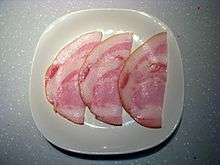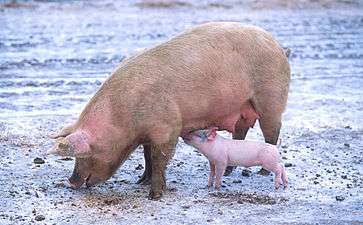Pork jowl


Pork jowl (alternately called jowl bacon or, especially in the Southern United States, hog jowl) is cured and smoked cheeks of pork. Hog jowl is a staple of soul food,[1] but is also used outside the United States; the Italian non-smoked variant is called guanciale.[2][3]
Uses
Jowl bacon can be fried and eaten as a main course, similar to streaky bacon, such as in a traditional full English breakfast. Often, it is used as a seasoning for beans, black-eyed peas or cooked with leafy green vegetables such as collard greens or turnip greens in a traditional Southeastern meal.[4][5] A Southern US tradition of eating black-eyed peas and greens with either pork jowls or fatback on New Year's Day to ensure prosperity throughout the new year goes back hundreds of years.[6]
Jowl meat may also be chopped and used as a garnish, similar to bacon bits,[7] or served in sandwich form.[8]
Pork jowl can be used as a binding ingredient in pork liver sausages such as liverwurst and braunschweiger.
Because pork jowl is cured, like many other cuts of pork, it has been a traditional wintertime food as it is able to be stored for long periods of time without refrigeration.
Health risks
Like most cured pork products, pork jowls are high in nitrates and sodium, which give the potential for health risks, particularly for those with a family history of heart disease.[6]
See also
References
- ↑ Gillespie, Carmen (2009). Toni Morrison: A Literary Reference to Her Life and Work. Infobase Publishing. p. 343. ISBN 9781438108575. Retrieved 28 July 2012.
- ↑ Fabricant, Florence (September 13, 2011). "Pork Jowl With a Backwoods Whiff". New York Times. Retrieved July 27, 2012.
- ↑ May, Tony (2005-06-01). Italian Cuisine: The New Essential Reference to the Riches of the Italian Table. Macmillan. p. 11. ISBN 9780312302801. Retrieved 28 July 2012.
- ↑ Hedgepeth, William; Findley, John; Clayton, Al (2008). The Hog Book. University of Georgia Press. p. 23. ISBN 9780820332734. Retrieved 28 July 2012.
- ↑ Galiano, Amanda (December 31, 2010). "Hog Jowls and Pork: Explaining Southern New Year's Traditions". About.com. Retrieved July 27, 2012.
- 1 2 Credeur, Mary Jane (December 30, 2006). "Eating hog jowls may bring luck, at high price". Union-Tribune. Retrieved July 27, 2012.
- ↑ Gold, Jonathan (July 27, 2012). "Counter Intelligence: Next Door by Josie". Los Angeles Times. Retrieved July 27, 2012.
- ↑ Cox, Greg. "Little Hen's agrarian accent leaves a mouth-watering experience". News Observer. Retrieved July 27, 2012.
